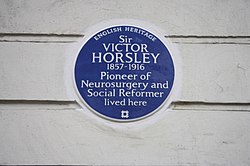Victor Horsley
Sir Victor Horsley | |
|---|---|
| (1894) |
Sir Victor Alexander Haden Horsley
He was born in
In 1886, he was appointed as Assistant Professor of Surgery at the
Personal life
This section needs additional citations for verification. (January 2023) |
Victor Alexander Haden Horsley was born in
In 1883, he became engaged to Eldred Bramwell, daughter of Sir
He was knighted in the 1902 Coronation Honours,[3] receiving the accolade from King Edward VII at Buckingham Palace on 24 October that year.[4]
Horsley was a champion of many causes. One of his primary life crusades was the temperance movement. Having observed that many injuries admitted to the hospital were due to alcohol, Horsley threw himself into becoming a temperance reformer. He soon rose up to the position of vice president of the
According to his biographers, Tan & Black (2002), "Horsley's kindness, humility, and generous spirit endeared him to patients, colleagues, and students. Born to privilege, he was nonetheless dedicated to improving the lot of the common man and directed his efforts toward the suffrage of women, medical reform, and free health care for the working class (...) An iconoclast of keen intellect, unlimited energy, and consummate skill, his life and work justifies his epitaph as a "pioneer of neurological surgery".
Medical career


Horsley specialised in surgery and in
As a neuroscientist, he carried out studies of the functions of the brain in animals and humans, particularly on the
He was also a pioneer in the study of the functions of the
Appointed in 1886 as secretary to a governmental commission formed to study the anti-rabies
In June 1886, he was elected a
Horsley, who had been a keen rifle shot when serving in the
His best-known innovation is the
He authored the book Functions of the Marginal Convolutions (1884) and, as a co-author, Experiments upon the Functions of the Cerebral Cortex (1888) and Alcohol and the Human Body (1902).
Political career
Horsley was a
Horsley strongly supported the Liberals' welfare state initiative, the National Insurance Act of 1911, despite strong opposition from most of his medical colleagues.[10]
First World War service and death

In 1910, Horsley was commissioned as a
Namesakes
Horsley was the first neurosurgeon appointed to the hospital in Queen Square, London, now called the National Hospital for Neurology and Neurosurgery – the Victor Horsley Department of Neurosurgery is named in his honour.
The Walton Centre for Neurology & Neurosurgery NHS Trust in Liverpool, England, another leading Neurosurgical Hospital, dedicated its intensive care unit to him, naming it the Horsley ward.
At its Annual Representatives Meeting, the British Medical Association has a series of lunchtime lectures entitled The Victor Horsley Lectures. After the Second Gulf War, a British Field Hospital was established at Shaibah Logistics Base, and the area of tented accommodation for hospital staff was known as Horsley Lines.
Horsley is credited with the invention of the "Horsley Hook", a device which he used to avulse the trigeminal nerve.
References
- ^ "Horsley, Sir Victor Alexander Haden". Who's Who. Vol. 59. 1907. p. 876.
- ^ a b c
PMID 13413250.
- ^ "The Coronation Honours". The Times. No. 36804. London. 26 June 1902. p. 5.
- ^ "No. 27494". The London Gazette. 11 November 1902. p. 7165.
- ^ "Library and Archives catalog". The Royal Society. Retrieved 14 October 2010.[permanent dead link]
- ^ S2CID 43580043. It dates the beginning of the experiments to 1894.
- ^ a b Dictionary of National Biography, 1912–1921. Oxford University Press. 1922. p. 271. It dates beginning of the experiments to 1893.
- ^ The Newly Restored Bird Bath Memorial near the Thomas Carlyle Statue, Hilda Kean, hildakean.com
- ^ Who Was Who, 1916–1928. A and C Black. 1947. p. 519.
- ^ Michael S. Dunnill, "Victor Horsley (1857–1915) and National Insurance." Journal of Medical Biography 21.4 (2013): 249-254.
- ^ Kelly's Handbook to the Titled, Landed and Official Classes, 1916. Kelly's. p. 782.
Further reading
- Tan, Tze-Ching; Black, Peter McL. (March 2002). "Sir Victor Horsley (1857–1916): pioneer of neurological surgery". PMID 11841730.
- Hanigan, William C. (1994). "Obstinate valour: the military service and death of Sir Victor Horsley". PMID 7946016.
- "Sir Victor Horsley (1857–1916)". 3 January 2010. Archived from the original on 10 June 2011. Retrieved 28 July 2010.
- PMID 4863669.
- "Horsley Papers". AIM25. 1790–1965. Archived from the original on 21 June 2008. Retrieved 28 July 2010.
